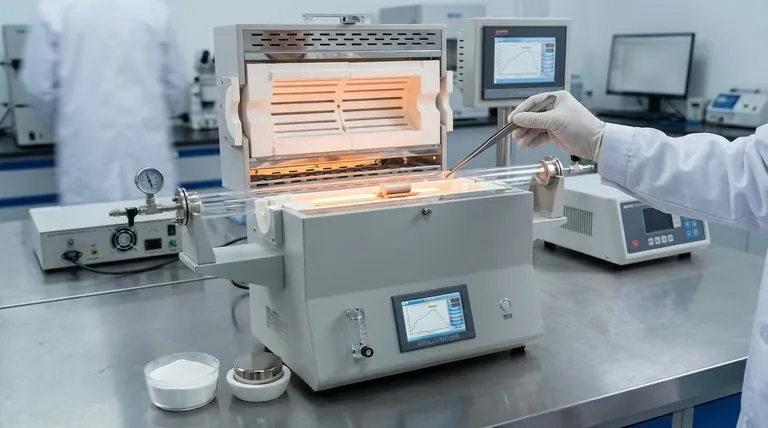In essence, ceramic sintering is a high-performance manufacturing process that uses intense heat and pressure to compact fine mineral powders into an incredibly dense and durable solid mass. This is achieved without melting the material, instead causing the individual particles to fuse together on an atomic level, radically enhancing the material's final properties.
Sintering is not merely about drying or baking a material; it is a fundamental transformation process. It engineers a new material from a collection of particles, creating a final product with strength and resilience far exceeding its constituent parts.

How Sintering Transforms Raw Materials
The magic of sintering lies in its ability to force separate particles to bond into a single, cohesive unit. This happens through a carefully controlled application of extreme force and thermal energy.
The Starting Point: A Fine Powder
The process begins with natural materials such as clay, feldspar, silica, and quartz. These raw minerals are ground into a fine, consistent powder, which serves as the foundation for the new material.
The Role of Extreme Pressure
This powder is then subjected to immense pressure, sometimes described as exceeding the weight of the Eiffel Tower. This step forces the individual particles into intimate contact, eliminating most of the air and voids between them.
The Function of High Heat
Next, the compacted material is fired in a kiln at temperatures often reaching 1200°C (2200°F). This intense heat provides the energy for atoms on the surfaces of adjacent particles to diffuse and bond together, a process known as solid-state diffusion.
The Result: A Dense, Solid Mass
The final product is a non-porous, ultra-compact slab. The spaces between the original particles have been eliminated, resulting in a material with exceptional density and a uniform internal structure.
The Benefits: Why Sintering Matters
Sintering is employed because it unlocks a level of performance that is impossible to achieve through other means. The properties of a sintered ceramic are a direct result of its ultra-dense, fused structure.
Unlocking Extreme Hardness and Strength
The tight atomic bonds created during sintering result in exceptional hardness and strength. For technical ceramics like zirconia, the process even induces a change in its crystalline structure, transforming it into an extremely hard and dense state used for demanding industrial applications.
Creating Near-Impervious Surfaces
Because a sintered ceramic has virtually zero porosity, it is highly resistant to external elements. This makes it waterproof and exceptionally resistant to staining, as there are no pores for liquids to penetrate.
Ensuring Long-Term Durability
This dense structure also provides superior resistance to scratching, abrasion, and high heat. Sintered surfaces do not fade from UV rays, making them suitable for both high-traffic indoor areas and demanding outdoor applications.
What "Sintering" Truly Means
Understanding the nuances of the process is key to appreciating the final product. The term implies a specific and controlled method of manufacturing.
It's a Transformation, Not Just Melting
A critical distinction is that sintering occurs below the material's melting point. The particles fuse while remaining in a solid state, which preserves a strong crystalline structure. This is fundamentally different from melting and casting, which creates a different internal structure upon cooling.
The Process Dictates the Properties
Terms like "ultra-compact surface" are not just marketing; they are direct descriptions of the outcome. The exceptional performance of sintered stone is a direct consequence of the compaction and atomic fusion that defines the sintering process.
It's a High-Performance Method
While many ceramics are fired in a kiln, sintering represents a more advanced and intensive process. It is used specifically when the goal is to create a material with the highest possible density, hardness, and durability.
How to Apply This Knowledge
Understanding sintering helps you make informed decisions when selecting materials for a project.
- If your primary focus is durability for a countertop or flooring: A sintered ceramic provides unmatched resistance to scratches, stains, and heat compared to many natural stones or other engineered surfaces.
- If your primary focus is an outdoor application: The inherent UV stability and weather resistance of a sintered surface make it a superior choice for cladding or outdoor kitchens.
- If your primary focus is specifying a high-strength technical part: Recognizing that a ceramic is "sintered" confirms it has undergone a process designed to maximize density and mechanical strength.
Ultimately, sintering is the engineering process that transforms humble powders into materials with extraordinary performance.
Summary Table:
| Key Aspect | Description |
|---|---|
| Process | Fusing fine mineral powders using heat and pressure without melting. |
| Primary Benefit | Creates materials with extreme hardness, strength, and zero porosity. |
| Common Applications | High-strength technical parts, durable countertops, outdoor cladding. |
Need a reliable sintering furnace for your lab? KINTEK specializes in high-performance lab equipment, including sintering furnaces designed for precise temperature control and uniform heating. Whether you're developing advanced ceramics or manufacturing durable components, our solutions ensure consistent, high-quality results. Contact our experts today to find the perfect sintering solution for your specific needs!
Visual Guide

Related Products
- 1400℃ Laboratory Quartz Tube Furnace with Alumina Tube Tubular Furnace
- Laboratory Muffle Oven Furnace Bottom Lifting Muffle Furnace
- 1700℃ Laboratory Quartz Tube Furnace with Alumina Tube Tubular Furnace
- 1800℃ Muffle Oven Furnace for Laboratory
- 1700℃ Muffle Oven Furnace for Laboratory
People Also Ask
- How to clean a tube furnace? A Step-by-Step Guide for Safe and Effective Maintenance
- What is the high temperature of a tube furnace? Unlock the Right Model for Your Application
- What is a tubular furnace used for? Precision Heating for Material Synthesis & Analysis
- What materials are used for the tubes in tube furnaces? A Guide to Selecting the Right Tube for Your Process
- How does a tubular furnace work? A Guide to Controlled High-Temperature Processing



















